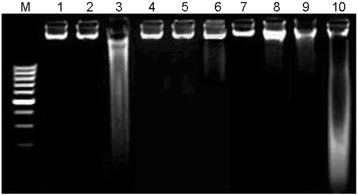Evaluation of Rumex hastatus leaves against hepatic fibrosis: a rat model
- PMID: 28854968
- PMCID: PMC5577788
- DOI: 10.1186/s12906-017-1943-5
Evaluation of Rumex hastatus leaves against hepatic fibrosis: a rat model
Abstract
Background: Rumex hastatus leaves have been widely used as food additive and for the treatment of various liver ailments. According to our previous studies, ethyle acetate (ERL) and methanolic (MRL) fractions of R. hastatus leaves are an accessible source of natural antioxidants. In the present research work we arranged to investigate the R. hastatus leaves as hepaptoprotective agent verse hepatic damages caused by CCl4.
Methods: During this project we divided 48 rats into eight groups randomly. CCl4-induced damages were assessed through liver function markers viz.; alkaline phosphatase (ALP), alanine transaminase (ALT), aspartate transaminase (AST), γ-glutamyltransferase (γ-GT) and lactate dehydrogenase (LDH). Changes in lipid profile were checked by measuring serum total cholesterol (TC), triglycerides (Tg), high density lipoproteins (HDL) and low density lipoproteins (LDL). Antioxidant status was checked by the activities of antioxidant enzymes, DNA damages and cellular abnormalities at histo level.
Results: Administration of CCl4 in rats caused significant increase in liver function and lipid profile indicating hepatic damages which were restored by co-administration of R. hastatus extracts. Cellular and DNA damages in hepatic tissues were caused by CCl4 which shown clear hepatic fibrosis in addition to disturb antioxidant enzyme level. Co-treatment with various fractions of R. hastatus leaves regulated these markers of oxidative dysfunctions.
Conclusion: From the present report it was inferred that R. hastatus leaves have the ability to reverse CCl4 - induced hepatic damages.
Keywords: Carbon tetrachloride; Fibrosis; Hepatotoxicity; Oxidative stress; Rumex hastatus; leaves.
Conflict of interest statement
Ethics approval and consent to participate
The study was conducted according to the protocol approved by ethical committee of the University.
Consent for publication
All the authors are agreeing to submit the paper in your esteemed Journal.
Competing interests
The authors declare that they have no competing interest.
Publisher’s Note
Springer Nature remains neutral with regard to jurisdictional claims in published maps and institutional affiliations.
Figures


Similar articles
-
Ameliorating effect of various fractions of Rumex hastatus roots against hepato- and testicular toxicity caused by CCl4.Oxid Med Cell Longev. 2013;2013:325406. doi: 10.1155/2013/325406. Epub 2013 May 14. Oxid Med Cell Longev. 2013. PMID: 23766852 Free PMC article.
-
White butterfly (Clerodendrum volubile) leaf extract protects against carbon tetrachloride-induced hepatotoxicity in rats.Biomed Pharmacother. 2017 Dec;96:924-929. doi: 10.1016/j.biopha.2017.12.005. Epub 2017 Dec 7. Biomed Pharmacother. 2017. PMID: 29224792
-
Hepatoprotective effects of methanol extract of Carissa opaca leaves on CCl4-induced damage in rat.BMC Complement Altern Med. 2011 Jun 24;11:48. doi: 10.1186/1472-6882-11-48. BMC Complement Altern Med. 2011. PMID: 21699742 Free PMC article.
-
Posttreatment Effects of Olea Europaea L. Leaf Extract on Carbon Tetrachloride-Induced Liver Injury and Oxidative Stress in Rats.J Med Food. 2018 Sep;21(9):899-904. doi: 10.1089/jmf.2017.0143. Epub 2018 Mar 20. J Med Food. 2018. PMID: 29648970
-
Protective effects of Fraxinus xanthoxyloides (Wall.) leaves against CCl4 induced hepatic toxicity in rat.BMC Complement Altern Med. 2016 Oct 24;16(1):407. doi: 10.1186/s12906-016-1398-0. BMC Complement Altern Med. 2016. PMID: 27776508 Free PMC article.
Cited by
-
Comparison of the Efficacy, Side Effects, and Cost of Modafinil and Intranasal Mometasone Furoate in Obstructive Sleep Apnea-Hypopnea Syndrome: A Preliminary Clinical Study.Med Sci Monit. 2018 May 11;24:3084-3092. doi: 10.12659/MSM.907565. Med Sci Monit. 2018. PMID: 29749371 Free PMC article.
-
Downregulation of miR-152 contributes to the progression of liver fibrosis via targeting Gli3 in vivo and in vitro.Exp Ther Med. 2019 Jul;18(1):425-434. doi: 10.3892/etm.2019.7595. Epub 2019 May 20. Exp Ther Med. 2019. PMID: 31258681 Free PMC article.
-
Rumex nervosus could alleviate streptozotocin-induced diabetic nephropathy in rats by activating Nrf2 signaling.Sci Prog. 2022 Apr-Jun;105(2):368504221102751. doi: 10.1177/00368504221102751. Sci Prog. 2022. PMID: 35619568 Free PMC article.
References
MeSH terms
Substances
LinkOut - more resources
Full Text Sources
Other Literature Sources
Medical
Miscellaneous

